DRIVING AN A. E. C .
Page 68

If you've noticed an error in this article please click here to report it so we can fix it.
WITH AN AUSTRALIAN ACCENT
THE special version of the A.E.C. Regal Mk. VI, model 3U5RA, designed to suit Australian city transport requirements, was the subject of a special demonstration last week. The prototype chassis, loaded to a gross weight of 12 tons 4 cwt., was driven from tfle manufacturers' works at Southall over a run of about 50 miles via Denham, Amersham, Berkhamsted, Princes Risborough to High Wycombe, and back via a similar route. The driving was taken in turn by a number of technical journalists, among whom I was included.
The vehicle has been designed with the known preferences of the principal Australian passenger transport authorities in mind. It is understood that it is planned to operate it as a demonstration model in Sydney and that a similar vehicle is to go to Adelaide for trial. In both eases, underfloor-engined A.E.C. buses are already in use in some quantity.
Fully Automatic Transmission The main point of interest lay in the fully automatic transmission. This incorporates a Spicer Type 184 three-stage torque converter imported from the United States. A short gear lever is used to select forward, neutral or reverse by means of a constant-mesh gear train, but no other overriding device is provided. With forward drive selected and the engine idling, there is no tendency to creep. This is because a multi-plate clutch connecting the engine to the converter turbine is disengaged until the engine speed rises. The clutch is hydraulically operated, the fluid pressure being obtained from an • engine-driven, and therefore speed-sensitive, pump.
The torque converter has a stall torque ratio of approximately 5.5 to 1 and this diminishes towards I to 1 as the speed rises. A centrifugal governor then operates a second clutch, giving direct drive, and after a brief transition period the primary clutch is disengaged, thus bypassing the torque converter completely.
Smooth Take-off The change point from converter to direct drive occurred at about 21 m.p.h., regardless of load, and when a climb required re-engagement of the converter this occurred at about 18 m.p.h.
One might have anticipated a rather sluggish and " wooden " performance from a system lacking any form of geared ratio change, load-sensitive device or manual overriding control. In fact, the transmission was remarkably effective. The take-off from rest was smooth under all conditions, as was the engagement of direct drive despite the fact that this caused a noticeable drop in engine speed.
When moving off, the engine note rises to an almost constant level until direct drive is engaged, in much the same way as occurred with the Leyland gearless buses of the 'thirties and the Crossley Turbotransmitter models of the early post-war period. This gives an impression of sluggish acceleration, but a rough check, taken in one direction only, gave the praiseworthy figure of 6.5 sec. for 0 to 20 m.p.h. A misunderstanding over the error of the speedometer caused a 0-38 m.p.h., rather than the usual 0-30 m.p.h.. figure to be similarly checked, the t being 20.6 sec.
Undoubtedly the lively acceleration partly due to the good power-weight ra which was 14.8 b.h.p./ton as tested, v engine developing 180 b.h.p. net at 2, r.p.m., and the unusually low rear-s gearing,. the ratio being 6.85 tO I. ' theoretical maximum gradients climbs in direct drive works out at 1 in 11 figure comparable to that given by sc small private cars; and certainly the the engine pulled immediately after change to direct drive was most imp sive for a vehicle of this type. The gearing makes the engine seem rat " busy" when running at over 35 m.r however, and the maximum speed pro to be in the region of 42 m.p.h. F consumption was not checked, but form of transmission and the geat would hardly be conducive to economy British standards.
The air suspension appeared to giv good ride amidships but, as often happ when testing an underfloor-cngined cl sis rather than a complete vehicle, frame deflections made that at the ft end rather choppy. At certain spe there was an unpleasant bouncing eff but this should disappear when the bl is fitted. The same may well apply a trace of steering kick. The steering somewhat heavy and seemed out of et acter with the power available to go ; stop as a result of quite moderate p sure on accelerator and brakes, but i understood that the optional power ast ance is not greatly favoured in AuStra
A.A.7
















































































































